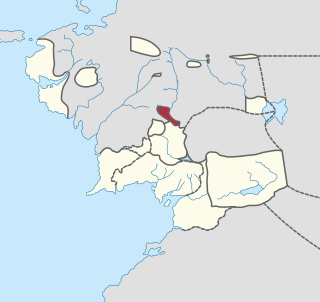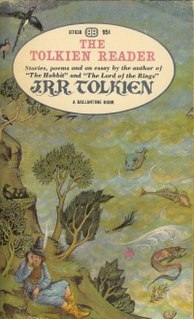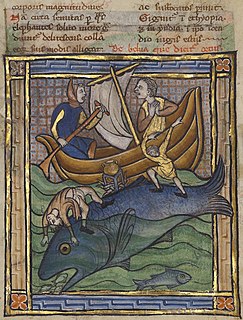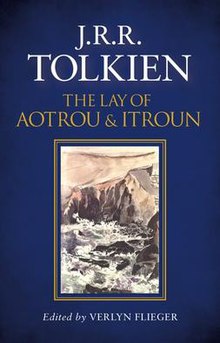
In J. R. R. Tolkien's legendarium, Lothlórien or Lórien is the fairest realm of the Elves remaining in Middle-earth during the Third Age. It is ruled by Galadriel and Celeborn from their city of tree-houses at Caras Galadhon. The wood-elves of the realm are known as Galadhrim.
In J. R. R. Tolkien's novel The Lord of the Rings, the Battle of the Pelennor Fields [pɛˈlɛnnɔr] was the defence of the city of Minas Tirith by the forces of Gondor and the cavalry of its ally Rohan, against the forces of the Dark Lord Sauron from Mordor and its allies the Haradrim and the Easterlings. It was the largest battle in the War of the Ring. It took place at the end of the Third Age in the Pelennor Fields, the townlands and fields between Minas Tirith and the River Anduin.

"The Man in the Moon Stayed Up Too Late" is J. R. R. Tolkien's imagined original song behind the nursery rhyme "Hey Diddle Diddle ", invented by back formation. It was first published in Yorkshire Poetry magazine in 1923, and was reused in extended form in the 1954–55 The Lord of the Rings as a song sung by Frodo Baggins in the Prancing Pony inn. The extended version was republished in the 1962 collection The Adventures of Tom Bombadil.
"Errantry" is a three-page poem by J.R.R. Tolkien, first published in The Oxford Magazine in 1933. It was included in revised and extended form in Tolkien's 1962 collection of short poems, The Adventures of Tom Bombadil. Donald Swann set the poem to music in his 1967 song cycle, The Road Goes Ever On.

The Tolkien Reader is an anthology of works by J. R. R. Tolkien. It includes a variety of short stories, poems, a play and some non-fiction. It compiles material previously published as three separate shorter books, together with one additional piece and introductory material. It was published in 1966 by Ballantine Books in the USA.
This is a list of all the published works of the English writer and philologist J. R. R. Tolkien, ranging from fiction to poetry and, ultimately, to academic and other works.
A Elbereth Gilthoniel is an Elvish hymn to Varda (Elbereth) in J. R. R. Tolkien's The Lord of the Rings. It is written in Sindarin, and not translated in the main text where it is first presented.
"The Sea-Bell" or "Frodos Dreme" is a poem with elaborate rhyme scheme and metre by J.R.R. Tolkien in his 1962 collection of verse The Adventures of Tom Bombadil. It was a revision of a 1934 poem called Looney. The first-person narrative speaks of finding a white shell "like a sea-bell", and of being carried away to a strange and beautiful land.
In J. R. R. Tolkien's legendarium, Elves are a fictional race inhabiting Middle-earth in the remote past. Unlike Men and Dwarves, Elves are immortal. They appear in The Hobbit and in The Lord of the Rings, but their history is described more fully in The Silmarillion.
"Fastitocalon" is a medieval-style poem by J. R. R. Tolkien about a gigantic sea turtle. The setting is explicitly Middle-earth. The poem is included in The Adventures of Tom Bombadil.

The Fall of Arthur is an unfinished poem by J. R. R. Tolkien that is concerned with the legend of King Arthur. A posthumous first edition of the poem was published by HarperCollins in May 2013.
"Sellic Spell" is a short prose text available in Modern and Old English redactions, written by J.R.R. Tolkien in a creative attempt to reconstruct the folktale underlying the narrative in the first two thousand lines of the Old English poem Beowulf. Among other things, it seeks to clarify and integrate a number of narrative strands in the early medieval poem. The resulting text is a loose variant of the Skilful Companions type of folktale, in which each of several characters has a valuable but specific skill. Unlike in folktales of that type, however, the skills of Tolkien's characters do not supplement each other in the resolution of the narrative problem. Tolkien's recasting of the material also incorporates the sluggish youth motif and the abandonment of the hero at the waterfall, both elements found in the analogous Old Icelandic Grettis saga. The suggestion that a waterfall like that of Grettis saga was part of the original setting of the pool of monsters in Beowulf was made by W.W. Lawrence in 1912.
"The Tale of Aragorn and Arwen" is a story within the Appendices of J. R. R. Tolkien's The Lord of the Rings. It narrates the love of the mortal Man Aragorn and the immortal Elf-maiden Arwen, telling the story of their first meeting, their eventual betrothal and marriage, and the circumstances of their deaths. Tolkien called the tale "really essential to the story". In contrast to the non-narrative appendices it extends the main story of the book to cover events both before and after it, one reason it would not fit in the main text. Tolkien gave another reason for its exclusion, namely that the main text is told from the hobbits' point of view.
The poetry in The Lord of the Rings consists of the poems and songs written by J. R. R. Tolkien, interspersed with the prose of his high fantasy novel of Middle-earth, The Lord of the Rings. The book contains over 60 pieces of verse of many kinds; some poems related to the book were published separately. Seven of Tolkien's songs, all but one from The Lord of the Rings, were made into a song-cycle, The Road Goes Ever On, set to music by Donald Swann. All the poems in The Lord of the Rings were set to music and published on CDs by The Tolkien Ensemble.

Trees and forests play multiple roles in J. R. R. Tolkien's fantasy world of Middle-earth, some such as Old Man Willow indeed serving as characters in the plot. Both for Tolkien personally, and in his Middle-earth writings, caring about trees really mattered. Indeed, the Tolkien scholar Matthew Dickerson wrote "It would be difficult to overestimate the importance of trees in the writings of J. R. R. Tolkien."
The impression of depth in The Lord of the Rings is an aesthetic effect deliberately sought by its author, J. R. R. Tolkien. It was intended to give the reader the feeling that the work had "deep roots in the past", and hence that it was attractively authentic.
J. R. R. Tolkien, a fantasy author and professional philologist, drew on the Old English poem Beowulf for multiple aspects of his Middle-earth legendarium. He used elements such as names, monsters, and the structure of society in a heroic age. He emulated its style, creating an impression of depth and adopting an elegiac tone. Tolkien admired the way that Beowulf, written by a Christian looking back at a pagan past, embodied a "large symbolism" without ever becoming allegorical. He worked to echo the symbolism of life's road and individual heroism in The Lord of the Rings.
J. R. R. Tolkien's presentation of Heroism in The Lord of the Rings is based on medieval tradition, but modifies it, as there is no single hero but a combination of heroes with contrasting attributes. Aragorn is the man born to be a hero, of a line of kings; he emerges from the wilds and is uniformly bold and restrained. Frodo is an unheroic, home-loving Hobbit who has heroism thrust upon him when he learns that the ring he has inherited from his cousin Bilbo is the One Ring that would enable the Dark Lord Sauron to dominate the whole of Middle-earth. His servant Sam sets out to take care of his beloved master, and rises through the privations of the quest to destroy the Ring to become heroic.

J. R. R. Tolkien was attracted to medieval literature, especially poetry, and made use of it in his writings both in his poetry, which contained numerous pastiches of medieval verse, and in his Middle-earth writings where he embodied a wide range of medieval concepts.

Tolkien's Art: A 'Mythology for England' is a 1979 book of Tolkien scholarship by Jane Chance, writing then as Jane Chance Nitzsche.







